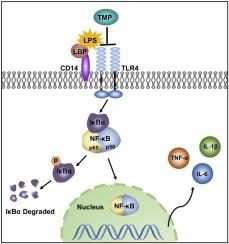Biomedicine & Pharmacotherapy ( IF 6.9 ) Pub Date : 2020-05-24 , DOI: 10.1016/j.biopha.2020.110273 Xiaokun Han 1 , Xi Chen 1 , Shuilian Chen 1 , Qian Luo 1 , Xuan Liu 1 , Anqi He 1 , Shengyu He 1 , Jin Qiu 1 , Pei Chen 1 , Yihui Wu 1 , Jiejie Zhuang 1 , Meng Yang 1 , Chuangran Wu 1 , Nandan Wu 1 , Ying Yang 1 , Jian Ge 1 , Jing Zhuang 1 , Keming Yu 1

|
Ocular inflammation is a common pathological condition of a series of retinal degenerative diseases. Tetramethylpyrazine (TMP), a Chinese herbal extraction, is widely used in the treatment of several ocular diseases in Eastern countries. However, the exact mechanisms correlating the vision protective effects of TMP have not been elucidated. Thus, this study aimed to investigate TMP’s molecular targets in anti-inflammatory activity in endotoxin lipopolysaccharide (LPS)-induced retinal inflammation both in vitro and in vivo. The primary cultured retinal microglial cells were pretreated with TMP and then activated by LPS. We found pretreatment with TMP significantly inhibited LPS-induced upregulation of CD68, a marker of mononuclear microglia activation. The morphological changes induced by LPS were also inhibited by the TMP pretreatment. Moreover, Toll like receptor 4 (TLR4), phosphorylation of inhibitor of NF-κB alpha (p-IκB-α) and the translocation of nuclear factor kappa B p65 (NF-κB p65) were significantly downregulated in retinal microglial cells with TMP pretreatment, which indicated that TMP might suppress LPS-induced retinal microglial activation through TLR4/NF-κB signalling pathway. And these results were confirmed in vivo. Pretreatment with TMP inhibited microglial activation, migration and regeneration, especially in ganglion cell layer (GCL). In addition to the inhibition of TLR4, TMP significantly inhibited the translocation of NF-κB p-65 to the nucleus in vivo. The downstream genes of NF-κB, such as the pro-inflammatory cytokines interleukin-6 (IL-6), tumor necrosis factor alpha (TNF-α) and interleukin-1β (IL-1β), were significantly downregulated by TMP pretreatment in the retina. Accordingly, the increased expression of cleaved caspase-3 and the decreased ratio of B-cell lymphoma-2 (Bcl-2) to Bcl-2 associated X Protein (Bax) were significantly attenuated by TMP. TUNEL assay also demonstrated that TMP exerted neuroprotective effects in the retina. Therefore, this study elucidated a novel mechanism that TMP inhibits retinal inflammation by inhibiting microglial activation via a TLR4/NF-κB signalling pathway.
中文翻译:

四甲基吡嗪通过抑制经由TLR4 /NF-κB信号通路的小胶质细胞活化来减轻内毒素诱导的视网膜炎症。
眼部炎症是一系列视网膜退行性疾病的常见病理状况。四甲基吡嗪(TMP)是一种中草药提取物,在东方国家被广泛用于治疗几种眼部疾病。但是,尚未阐明与TMP视力保护作用相关的确切机制。因此,本研究的目的是调查中内毒素脂多糖TMP在抗炎活性的分子靶(LPS) -诱导的视网膜炎症二者在体外和体内。将原代培养的视网膜小神经胶质细胞用TMP预处理,然后通过LPS激活。我们发现用TMP预处理可显着抑制LPS诱导的CD68(单核小胶质细胞活化的标志物)的上调。TMP预处理还抑制了LPS诱导的形态变化。此外,TMP预处理在视网膜小胶质细胞中显着下调了Toll样受体4(TLR4),NF-κBα抑制剂的磷酸化(p-IκB-α)和核因子κBp65(NF-κBp65)的转运。提示TMP可能通过TLR4 /NF-κB信号通路抑制LPS诱导的视网膜小胶质细胞活化。这些结果在体内得到证实。用TMP预处理可抑制小胶质细胞的活化,迁移和再生,特别是在神经节细胞层(GCL)中。除了抑制TLR4,TMP还可以在体内显着抑制NF-κBp-65向核的转运。TMP预处理可显着下调NF-κB的下游基因,如促炎细胞因子白细胞介素6(IL-6),肿瘤坏死因子α(TNF-α)和白细胞介素1β(IL-1β)。视网膜。因此,TMP显着减弱了裂解的caspase-3表达的增加和B细胞淋巴瘤2(Bcl-2)与Bcl-2相关X蛋白(Bax)的比率降低。TUNEL分析还证明TMP在视网膜中发挥神经保护作用。因此,本研究阐明了一种新的机制,即TMP通过经由TLR4 /NF-κB信号通路抑制小胶质细胞活化来抑制视网膜炎症。






























 京公网安备 11010802027423号
京公网安备 11010802027423号